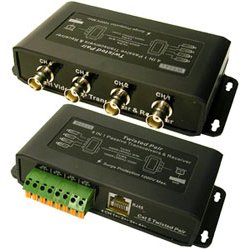 A 4 channel passive video balun is defined as a specialized electrical transformer that converts electrical signals that are balance about ground (differential) to signals that are unbalanced (or single-ended) and or converts signals that are unbalanced to balanced. In that manner they are used as devices that are used to connect lines of different impedance. Balun is derived from two separate words; BALance and UNbalance (BAL+UN).
A 4 channel passive video balun is defined as a specialized electrical transformer that converts electrical signals that are balance about ground (differential) to signals that are unbalanced (or single-ended) and or converts signals that are unbalanced to balanced. In that manner they are used as devices that are used to connect lines of different impedance. Balun is derived from two separate words; BALance and UNbalance (BAL+UN).
Wow! That was quite a mouthful. Let’s redefine the definition without the overly technical phrases. Simply put, any wire or cable has a natural resistance when electricity is applied. Consider this, what if you took a typical AAA dry-cell battery and connected a wire to each end of the battery. Now, what if the wire you attached was 5 miles long.
Would the end of the line still produce the same voltage or power as it does when the wire is only 1 foot long? The answer is “No” and the reason for it can be attributed to impedance. In other words, any wire, cable, or other metal electrical transmitting device has a natural resistance to electricity and electronic signals, even though it may be a great conductor. Since impedance is a type of resistance, the impedance of a cable or wire is expressed in ohms (Ώ).
When dealing with radio frequencies, a loss of the signal means the difference between a video image being transmitted to a Digital Video Receiver (DVR) or monitor or not. This can happen when the length of the cable is too long, unshielded, or mismatched in impedance. This is where the 4 channel passive video balun comes in.
The majority of digital video security and surveillance cameras today still use coaxial cable, specifically RG-59. RG-59 is a shielded cable that has an impedance of 75 ohms. A shielded cable is one that is wrapped in some sort of material (often aluminum, mesh wires, or even plastic for example) that keeps the desired radio frequency in, but more importantly prevents external noise from reaching the cable.
The 75 ohm impedance is no arbitrary accident. Video signals happen to have 75 ohm impedance, so the coaxial cable works well as the impedance of the coaxial cable and the impedance of the video signals are equal. As a matter of fact, not only does the coaxial cable and radio frequency have an impedance of 75 ohms but the in impedance for displays is usually 75 ohms as well. If you haven’t figured it out by now, for ideal quality video, it is important that the impedance of the objects involved in transmitting the signal have the same impedance, in this case 75 ohms.
Now, let’s switch gears for a moment. With the arrival of the computer age, so became the familiarity of CAT5 or Ethernet cable. Ethernet cable has twisted pairs of wires. By twisting the pairs of wires electromagnetic interference from external sources can be canceled out. However, for radio frequency applications, CAT5 twisted pair is not necessarily ideal because it contains no shielding to prevent outside noise (in the form of electromagnetic radiation). As a result of its configuration, CAT5 cable is often called UTP or Unshielded Twisted Pair cable.
Although CAT5 cable can be used for video transmission lines for digital video security cameras, it has one other undesirable characteristic: CAT5 UTP cable normally has an impedance of about 100 ohms. Since the camera is transmitting its video data at an impedance of 75 ohms and the DVR intends to receive it at 75 ohms there is a mismatch between the CAT5 cable and everything else.
How can we work around this mismatch? Use a 4 channel passive video balun. The video balun will correct for the mismatch of ohms going to and from the cable and may also correct for noise, white balance and other video signal attributes. Security Camera King offers a 4 channel passive video balun designed specifically for this purpose.
Product# Balun-4 not only matches the impedance factor to eliminate noise or distortion problems, but it allows you to send 4 different video signals over one CAT5 cable up to 1200 feet in length. Please be advised that when using a 4 channel passive video balun you will need to purchase two units. The first unit converts the signal from BNC to CAT5 and the second unit is need to convert the CAT5 back to BNC for use by the DVR.
